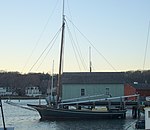Mystic massacre
1637 in the Thirteen Colonies17th-century massacresBattles in ConnecticutGroton, ConnecticutMassacres in the Thirteen Colonies ... and 8 more
Massacres of Native AmericansMilitary history of the Thirteen ColoniesMystic, ConnecticutNative American genocideNew London County, ConnecticutPequot WarPre-statehood history of ConnecticutUse mdy dates from May 2018

The Mystic massacre – also known as the Pequot massacre and the Battle of Mystic Fort – took place on May 26, 1637 during the Pequot War, when Connecticut colonists under Captain John Mason and their Narragansett and Mohegan allies set fire to the Pequot Fort near the Mystic River. They shot anyone who tried to escape the wooden palisade fortress and killed most of the village in retaliation for previous Pequot attacks. There were between 400 and 700 Pequot civilians killed during the massacre, and the only Pequot survivors were warriors who were away in a raiding party with their sachem Sassacus.
Excerpt from the Wikipedia article Mystic massacre (License: CC BY-SA 3.0, Authors, Images).Mystic massacre
Clift Street,
Geographical coordinates (GPS) Address Nearby Places Show on map
Geographical coordinates (GPS)
| Latitude | Longitude |
|---|---|
| N 41.359722222222 ° | E -71.976666666667 ° |
Address
Clift Street 240
06355
Connecticut, United States
Open on Google Maps








